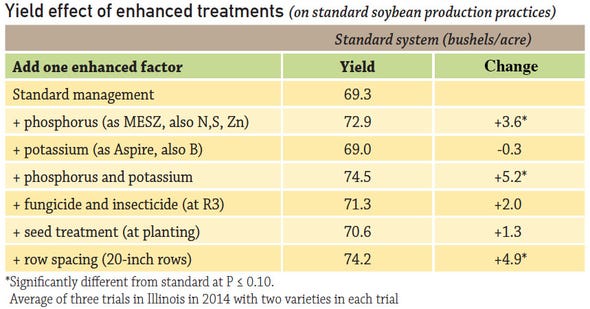October 12, 2015

Common wisdom that soybeans don’t respond to fertilizer is dead wrong. So is the widespread perception that potassium fertility is likely more limiting than phosphorus.
That’s according to Fred Below, a University of Illinois plant physiologist. Recent research he conducted with graduate students to break the 100-bushel/acre soybean yield barrier suggests both notions are in error.
“It’s a myth that soybeans don’t respond to fertilizer,” says Below, who adds that “wisdom” may be a carryover from research on soybean nitrogen fertility, which shows inconsistent response to extra nitrogen.
Misperception about phosphorus and potassium
Although soybeans require about four times more potassium than phosphorus for a yield of 60 bushels/acre, phosphorus is more likely to walk the line on adequacy at typical Illinois phosphorus and potassium application rates. Those rates trend around 90 pounds/acre of P2O5 and 100 pounds/acre of K20 in the corn year of a corn-soybean rotation, Below says.
That’s due in part to relatively large removal of phosphorus in corn grain compared to potassium. High late-season demand for phosphorus by soybeans also plays a role. “There is a huge demand for phosphorus in the seed, and there is a limited reservoir in the leaves and stem to draw from,” he adds.
“If you look at the average phosphorus and potassium application rates across the Corn Belt, farmers are under-fertilizing phosphorus and they are about adequate with potassium,” he adds. “We are actually mining the soil of phosphorus during the course of a corn-soybean rotation at typical phosphorus application rates.”
ROI of extra phosphorus
Applying extra phosphorus so it isn’t yield-limiting has been worth about 3.5 bushels/acre in Below’s research on adequate to high-testing soils in his plots from 2012 to 2014.

University of Illinois research on management practices for high-yielding soybeans shows that extra phosphorus fertility was the single-largest contributor to increasing yields compared to a standard program. Results were similar in trials conducted in 2012 and 2013. The yield impact of each individual treatment is shown.
“Phosphorus is the biggest single factor in driving yield increases in the past three years of our studies,” he says.
Below and his students apply 75 pounds/acre of P2O5 equivalent for the needs of a 100 bushel/acre crop. “For growing 60 bushel/acre soybeans, the more appropriate rate would be something in the 40 or 50 pounds of P2O5/acre range,” he says.
At a new-crop futures prices of about $9.40/bushel, 80 pounds/acre of MAP at $570/ton and application at $5/acre, net return on the extra investment could be about $5/acre, based on Below’s research. At the 100 pounds/acre of MAP, it would be break-even.
“Growers should work with an agronomist to zero in on the best application rate,” he says.
About the Author(s)
You May Also Like






